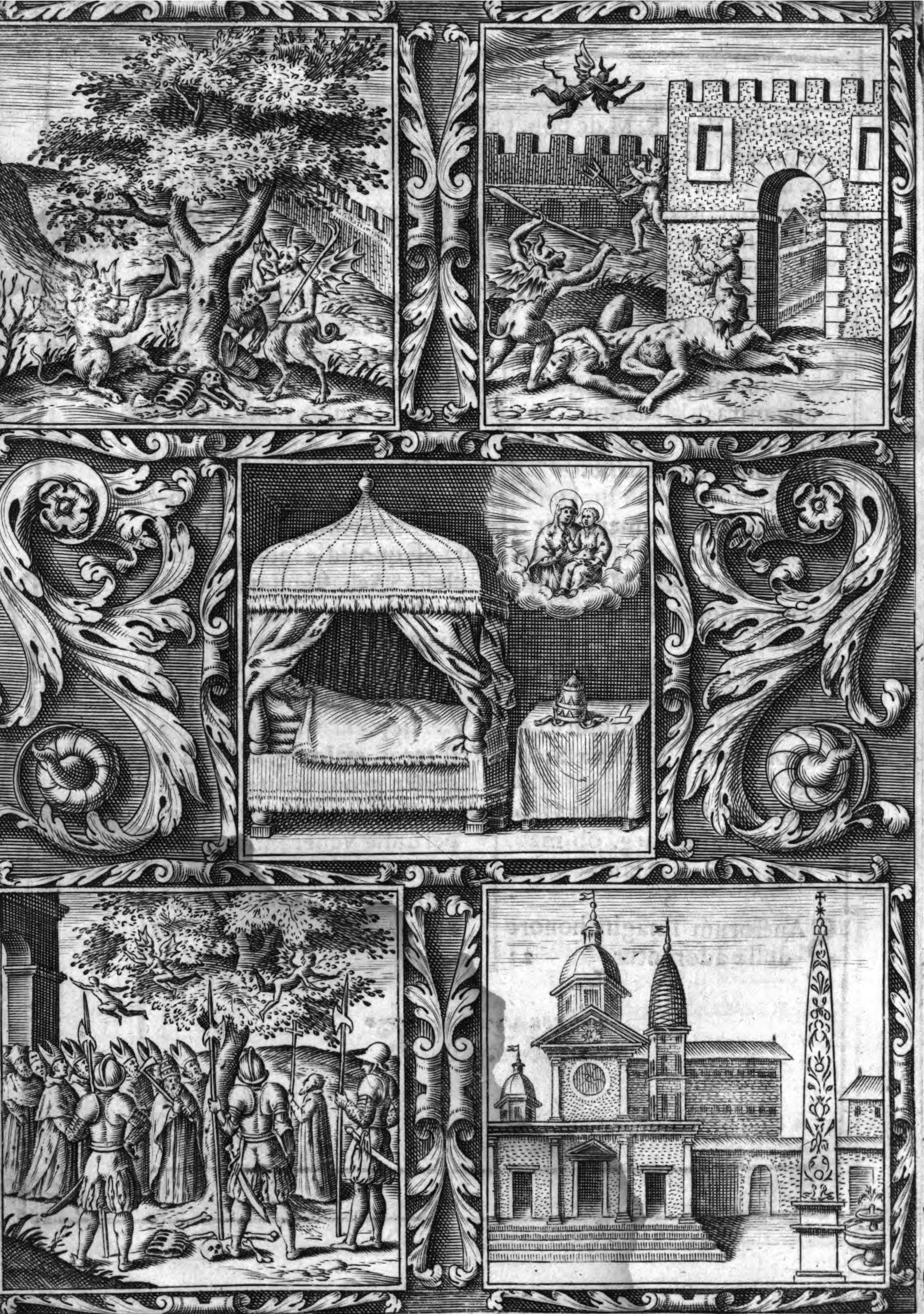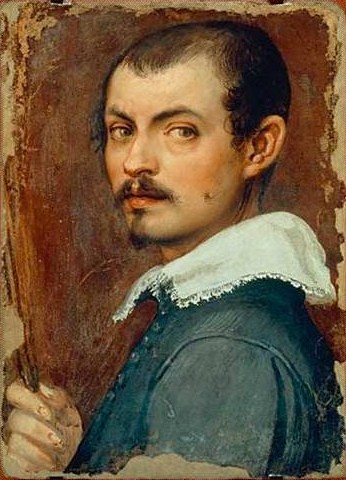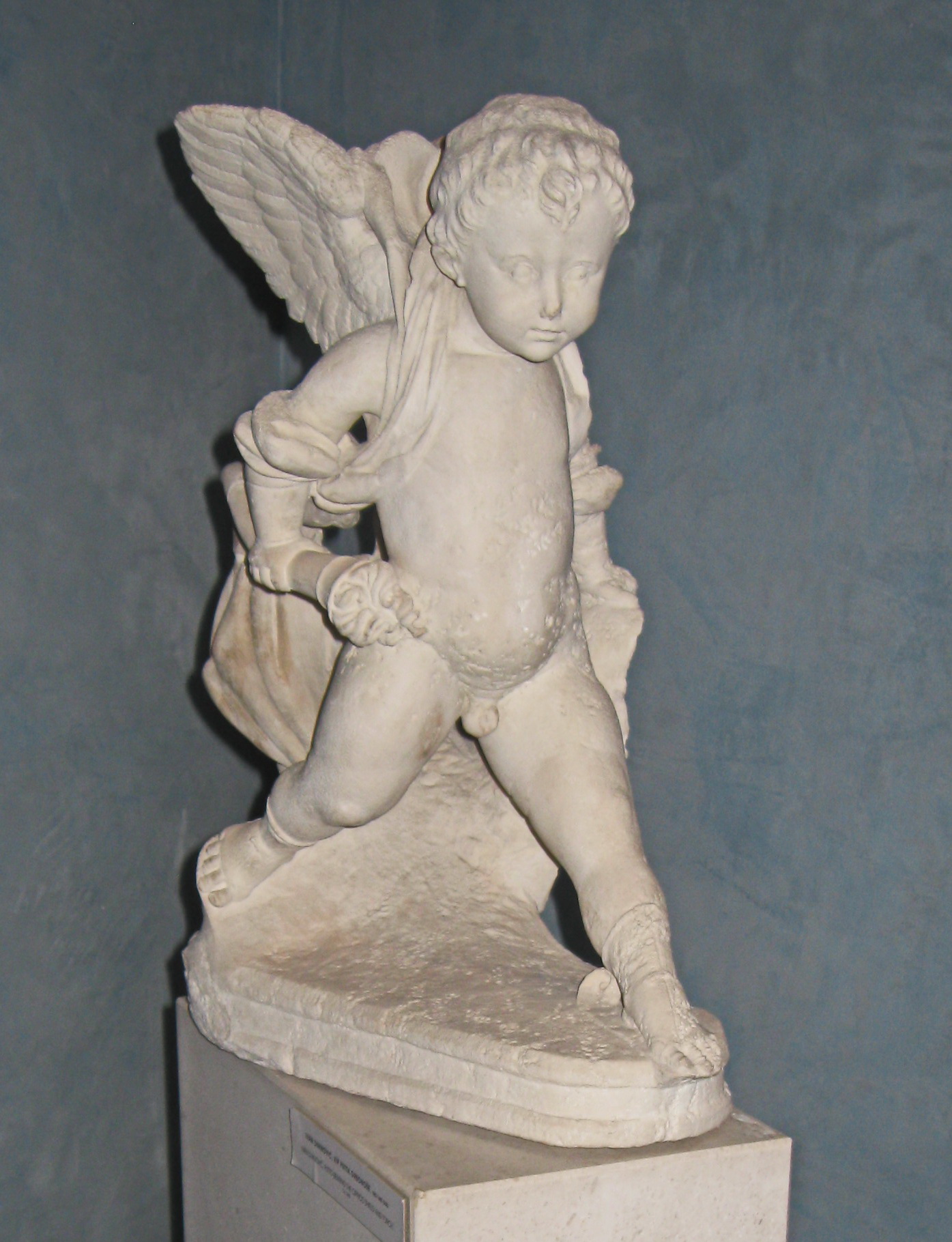|
Mellini Chapel (Santa Maria Del Popolo)
The Mellini or Saint Nicholas of Tolentino Chapel ( it, Cappella Mellini, Cappella di San Niccolò da Tolentino) is the third chapel on the left-hand side of the nave in the Church of Santa Maria del Popolo in Rome. The chapel contains several funeral monuments of the members of the Mellini family among them the works of Alessandro Algardi and Pierre-Étienne Monnot. History The first patron of the chapel was a celebrated jurist, Pietro Mellini who belonged to a noble and ancient Roman family. The chapel, which was dedicated to Saint Nicholas of Tolentino, is one of the original 15th-century hexagonal side chapels of the basilica. It has been the funeral place of the Mellini family for centuries. Originally it had two monumental Renaissance tombs facing each other, made for Cardinal Giovanni Battista Mellini and his brother, Pietro around 1478-83. A similar arrangement is still visible in other side chapels of the basilica. The appearance of the chapel was fundamentally changed w ... [...More Info...] [...Related Items...] OR: [Wikipedia] [Google] [Baidu] |
Basilica Of Santa Maria Del Popolo
it, Basilica Parrocchiale Santa Maria del Popolo , image = 20140803 Basilica of Santa Maria del Popolo Rome 0191.jpg , caption = The church from Piazza del Popolo , coordinates = , image_size = 270 , mapframe-frame-width = 270 , mapframe = yes , mapframe-caption = Click on the map for a fullscreen view , mapframe-zoom = 13 , mapframe-marker = religious-christian , mapframe-wikidata = yes , location = Rome , country = Italy , denomination = Catholic , tradition = Latin Church , religious order = Order of Saint Augustine , website = , founded date = 1099 , founder = Pope Paschal II , dedication = Blessed Virgin Mary , consecrated date = 1477 , status = Basilica minor, parish church (1561), titular church (1587) , functional status ... [...More Info...] [...Related Items...] OR: [Wikipedia] [Google] [Baidu] |
Giovanni Da San Giovanni
Giovanni da San Giovanni (20 March 1592 – 9 December 1636), also known as Giovanni Mannozzi, was an Italian painter of the early Baroque period, active in Florence. Biography Born in San Giovanni Valdarno, he trained under Matteo Rosselli. He is also said to have studied architectural perspective from Giulio Parigi. He traveled to Rome where he admired the fresco painted in 1614 by Guido Reni, depicting the Aurora. He was soon called back to Florence. Mannozzi started the decoration of the ''Sala degli Argenti'' in the Palazzo Pitti and planned decorations at Villa La Petraia. In 1615 he painted two ceiling canvases of ''Putti Supporting the profile of Michelangelo'' for the Casa Buonarroti and in the same period frescoed a choir of musician-angels for the dome of the church of the Ognissanti in Florence. He also painted five lunettes showing scenes from the ''Life of St Francis'' in the cloister of the Ognissanti. In 1619–1620 he directed the façade decoration of Pal ... [...More Info...] [...Related Items...] OR: [Wikipedia] [Google] [Baidu] |
Roman Catholic Diocese Of Senigallia
The Diocese of Senigallia ( la, Dioecesis Senogalliensis) is a Roman Catholic ecclesiastical territory in the Marche, Italy. It has existed since the sixth century. It is a suffragan of the archdiocese of Ancona-Osimo."Diocese of Senigallia" ''''. David M. Cheney. Retrieved February 29, 2016."Diocese of Senigallia" ''GCatholic.org.org''. Gabriel Chow. Retrieved February 29, 2016. History The patron saint of Senigallia is a St. Paulinus, whose remains are said to ...[...More Info...] [...Related Items...] OR: [Wikipedia] [Google] [Baidu] |
Santi Apostoli, Rome
Santi Dodici Apostoli (Church of the Twelve Holy Apostles; la, SS. Duodecim Apostolorum), commonly known simply as Santi Apostoli, is a 6th-century Roman Catholic parish and titular church and minor basilica in Rome, Italy, dedicated originally to St. James and St. Philip, whose remains are kept here, and later to all Apostles. Today, the basilica is under the care of the Conventual Franciscans, whose headquarters in Rome is in the adjacent building. The Cardinal Priest of the ''Titulus XII Apostolorum'' is Angelo Scola. Among the previous Cardinal Priests are Pope Clement XIV, whose tomb by Canova is in the basilica, and Henry Benedict Stuart. History Built by Pope Pelagius I to celebrate the victory of Narses, the general of the Emperor Justinian, over the Ostrogoths, and dedicated by Pope John III to St. James and Saint Philip the Apostle, the basilica is listed as "Titulus SS Apostolorum" in the acts of the synod of 499. Santi Apostoli was ruined by the earthquake o ... [...More Info...] [...Related Items...] OR: [Wikipedia] [Google] [Baidu] |
Giovanni Dalmata
Giovanni Dalmata ( hr, Ivan Duknović; c. 1440 – c. 1514), born Ioannes Stephani Duknovich de Tragurio, also known as Giovanni Duknovich di Traù in Italy and Ivan Stjepanov Duknović in Croatia, was a sculpture, sculptor from Trogir, Dalmatia, who was mainly active in Rome, Hungary and his native country during the European Renaissance. Dalmata was, with Mino da Fiesole and Andrea Bregno, one of the leading sculptors in Rome in the second half of the 15th century. Biography He was born in Vinišće, a Dalmatian village (now a part of Marina, Split-Dalmatia County, Marina) in Venetian Dalmatia around 1440. His father was Stjepan Duknović, a stonemason in Trogir. He came to Rome between 1460 and 1465 to work for Pope Paul II on the Palazzo di Venezia. Other works in and around Rome include: the ''Tempietto'' of S. Giacomo in Vicovaro (near Tivoli, Italy, Tivoli), the list of papal tombs, tomb monuments of Pope Paul II in St. Peter's (now dismantled), the tomb of Cardinal Bartolom ... [...More Info...] [...Related Items...] OR: [Wikipedia] [Google] [Baidu] |
Algardi Mellini
Alessandro Algardi (July 31, 1598 – June 10, 1654) was an Italian high-Baroque sculptor active almost exclusively in Rome, where for the latter decades of his life, he was, along with Francesco Borromini and Pietro da Cortona, one of the major rivals of Gian Lorenzo Bernini. He is now most admired for his portrait busts that have great vivacity and dignity. Early years Algardi was born in Bologna, where at a young age, he was apprenticed in the studio of Agostino Carracci. However, his aptitude for sculpture led him to work for Giulio Cesare Conventi (1577–1640), an artist of modest talents. His two earliest known works date back to this period: two statues of saints, made of chalk, in the Oratory of Santa Maria della Vita in Bologna. By the age of twenty, Ferdinando I, Duke of Mantua, began commissioning works from him, and he was also employed by local jewelers for figurative designs. After a short residence in Venice, he went to Rome in 1625 with an introduction from the D ... [...More Info...] [...Related Items...] OR: [Wikipedia] [Google] [Baidu] |
Man Of Sorrows
Man of Sorrows, a biblical term, is paramount among the prefigurations of the Messiah identified by the Bible in the passages of Isaiah 53 (''Servant songs'') in the Hebrew Bible. It is also an iconic devotional image that shows Christ, usually naked above the waist, with the wounds of his Passion prominently displayed on his hands and side (the "ostentatio vulnerum", a feature of other standard types of image), often crowned with the Crown of Thorns and sometimes attended by angels. It developed in Europe from the 13th century and was especially popular in Northern Europe. The image continued to spread and develop iconographical complexity until well after the Renaissance, but the Man of Sorrows in its many artistic forms is the most precise visual expression of the piety of the later Middle Ages, which took its character from mystical contemplation rather than from theological speculation. Together with the ''Pietà'', it was the most popular of the Andachtsbilder-type images ... [...More Info...] [...Related Items...] OR: [Wikipedia] [Google] [Baidu] |
Windsor Castle
Windsor Castle is a royal residence at Windsor in the English county of Berkshire. It is strongly associated with the English and succeeding British royal family, and embodies almost a millennium of architectural history. The original castle was built in the 11th century, after the Norman invasion of England by William the Conqueror. Since the time of Henry I (who reigned 1100–1135), it has been used by the reigning monarch and is the longest-occupied palace in Europe. The castle's lavish early 19th-century state apartments were described by early 20th century art historian Hugh Roberts as "a superb and unrivalled sequence of rooms widely regarded as the finest and most complete expression of later Georgian taste".Hugh Roberts, ''Options Report for Windsor Castle'', cited Nicolson, p. 79. Inside the castle walls is the 15th-century St George's Chapel, considered by the historian John Martin Robinson to be "one of the supreme achievements of English Perpe ... [...More Info...] [...Related Items...] OR: [Wikipedia] [Google] [Baidu] |
Pope Sixtus IV
Pope Sixtus IV ( it, Sisto IV: 21 July 1414 – 12 August 1484), born Francesco della Rovere, was head of the Catholic Church and ruler of the Papal States from 9 August 1471 to his death in August 1484. His accomplishments as pope included the construction of the Sistine Chapel and the creation of the Vatican Library. A patron of the arts, he brought together the group of artists who ushered the Early Renaissance into Rome with the first masterpieces of the city's new artistic age. Sixtus founded the Spanish Inquisition through the bull ''Exigit sincerae devotionis affectus'' (1478), and he annulled the decrees of the Council of Constance. He was noted for his nepotism and was personally involved in the infamous Pazzi conspiracy. Early life Francesco was born to a family of modest means from Liguria, Italy, the son of Leonardo della Rovere and Luchina Monleoni. He was born in Celle Ligure, a town near Savona. As a young man, Della Rovere joined the Franciscan Order, ... [...More Info...] [...Related Items...] OR: [Wikipedia] [Google] [Baidu] |
Roman Catholic Archdiocese Of Urbino-Urbania-Sant'Angelo In Vado
The Archdiocese of Urbino-Urbania-Sant'Angelo in Vado ( la, Archidioecesis Urbinatensis-Urbaniensis-Sancti Angeli in Vado) is a Latin Church ecclesiastical territory or archdiocese of the Catholic Church in the Province of Pesaro and Urbino in the Marche region of central Italy. The current archbishop is Giovanni Tani, appointed in June 2011. It was previously a metropolitan see. Its cathedral is a minor basilica and minor World Heritage site: Basilica Cattedrale di S. Maria Assunta, in Urbino. It has two co-cathedrals, both former cathedrals of absorbed diocese whose title was also adopted: another minor basilica, the Basilica Concattedrale di S. Michele Arcangelo, dedicated to the archangel Saint Michael, in Sant’Angelo in Vado, and the Concattedrale di S. Cristoforo Martire, dedicated to the protomartyr Saint Christopher, in Urbania. History Urbino is the ancient ''Urbinum Mataurense'', a Roman ''municipium''. Urbino was held by the Ostrogoths from the late 5th century, ... [...More Info...] [...Related Items...] OR: [Wikipedia] [Google] [Baidu] |
Giovanni Battista Mellini
Giovanni Battista Mellini (9 June, 1405 – 24 July, 1478) (called the Cardinal of Urbino) was an Italian Roman Catholic bishop and cardinal. Biography Giovanni Battista Mellini was born in Rome on 9 June 1405, the son of a noble family. He received funds from Pope Martin V to study law. When he was seven years old, Antipope John XXIII made him a canon of the Archbasilica of St. John Lateran. He resigned this canonry during the pontificate of Pope Nicholas V, who made him ''economous'' of St. Peter's Basilica. He served as ''Abbreviatore de parco maggiore'' under Pope Eugene IV; as corrector of papal letters under Pope Pius II; and as papal datary under Pope Paul II. On 27 April 1468 he was elected Bishop of Urbino. He subsequently held this see until his death. In the consistory of 16 December 1476, Pope Sixtus IV made him a cardinal priest. He received the red hat and the titular church of Santi Nereo e Achilleo on 30 December 1476. On 1 January 1477 the pope named ... [...More Info...] [...Related Items...] OR: [Wikipedia] [Google] [Baidu] |
Giovanni Mellini Tomb Watercolour
Giovanni may refer to: * Giovanni (name), an Italian male given name and surname * Giovanni (meteorology), a Web interface for users to analyze NASA's gridded data * ''Don Giovanni'', a 1787 opera by Wolfgang Amadeus Mozart, based on the legend of Don Juan * Giovanni (Pokémon), boss of Team Rocket in the fictional world of Pokémon * Giovanni (World of Darkness), a group of vampires in ''Vampire: The Masquerade/World of Darkness'' roleplay and video game * "Giovanni", a song by Band-Maid from the 2021 album ''Unseen World'' * ''Giovanni's Island'', a 2014 Japanese anime drama film * ''Giovanni's Room'', a 1956 novel by James Baldwin * Via Giovanni, places in Rome See also * * *Geovani *Giovanni Battista *San Giovanni (other) *San Giovanni Battista (other) San Giovanni Battista is the Italian translation of Saint John the Baptist. It may also refer to: Italian churches * San Giovanni Battista, Highway A11, a church in Florence, Italy * San Giovanni Battista, Pra ... [...More Info...] [...Related Items...] OR: [Wikipedia] [Google] [Baidu] |







